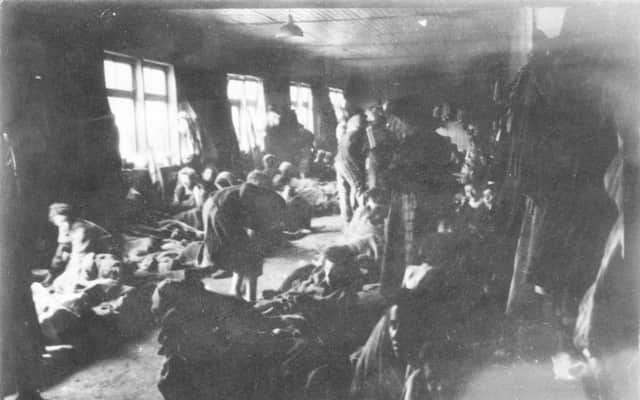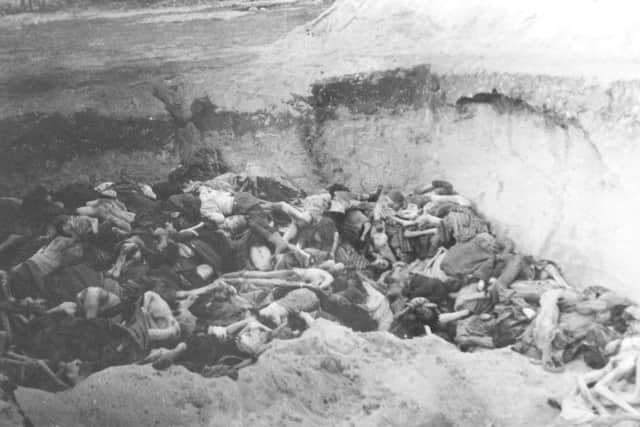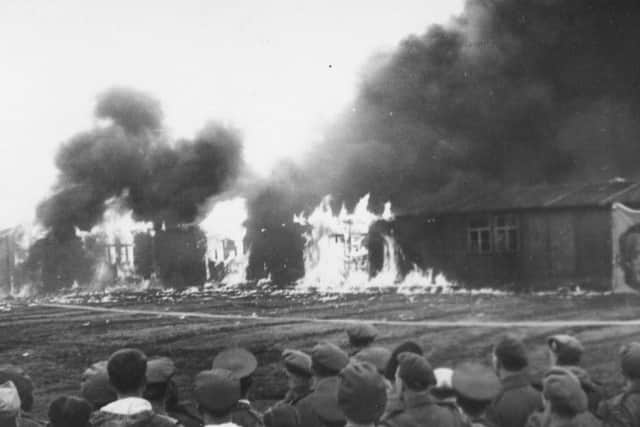Do new photos of Belsen show Anne Frank’s grave?


The images, released to mark the 70th anniversary of the liberation of Bergen-Belsen today, were taken by British reverend Charles Martin King Parsons.
The army chaplain from Leicestershire was present at the liberation of the Nazi concentration camp where Anne was held and captured the horror of the slaughter at the site.
Advertisement
Hide AdAdvertisement
Hide AdThe black-and-white images include pictures of the camp burning as well as horrific mass graves and piles of bodies that could have contained the young Jewish diarist.


An estimated 50,000 people, including Anne Frank, were killed at the camp, in northern Germany.
The chaplain’s great-grandson Tom Marshall, 27, decided to publish the shocking images after finding the pictures inside an old box among his grandmother’s possessions.
The photograph restorer and colouriser, who lives in Glasgow, said: “I often come across very interesting historical photographs showing stories that impel me to dig deeper and find out as much as I can about the people in the pictures, and what they did with their lives.
“I never knew him, but my grandmother said he never talked about his time in the war.


“I didn’t know why, but now I understand.
“We had no idea he had taken these pictures and I feel now is the right time to share them. Words struggle to describe the unbridled horror within.”
Mr Marshall’s great-grandfather served in the Royal Flying Corps during the First World War, and because he was aged 39 when the Second World War broke out, he initially joined the Home Guard.
He later joined the Royal Army Chaplain’s Department in 1943.
Advertisement
Hide AdAdvertisement
Hide AdOn 15 April 1945, British and Canadian forces liberated Bergen-Belsen. Rev Parsons was one of a handful of British Army chaplains who entered the camp in the days following liberation.
The pictures show a temporary sign erected by the British shortly after the camp was liberated from the Nazis, revealing just part of the horrendous death toll. Part of it reads: “10,000 unburied dead were found here. Another 13,000 have since died.”
Other pictures include the cramped and dirty conditions inside one of the huts, as well as a pit filled with the corpses of camp prisoners. During the course of the war, it became a concentration camp and the final resting place for over 50,000 Jews, Poles, Soviets, opponents to the Nazis, homosexuals and gypsies.
Mr Marshall said: “Perhaps the most discussed Jewish victim of the Holocaust, Anne Frank, died in Belsen shortly before the liberation, probably of typhus which was rife among the dying.
“When my great-grandfather arrived at the camp, there were nearly 500 people dying each day, from the appalling conditions and the typhus outbreak.
“Along with the other chaplains, medical staff and medical volunteers, he saved many lives and gave both spiritual and medical support to the survivors.
“They were all true heroes - I’m so proud he documented what he saw, because it’s important for future generations not to forget.”
After the war, Mr Marshall’s great-grandfather returned to his work as a vicar and raised two children, Tom’s grandmother Ruth, and Joan, before dying aged 54 in 1953.
Advertisement
Hide AdAdvertisement
Hide AdMr Marshall, originally from Leicestershire, added: “I never knew him, as he died 35 years before I was born but I do know he was a brave man who saved many lives.
“I have also come to learn how important the non-military members of the forces were, and still are – providing essential support and care at times of need.
“I’m very proud of my great-grandfather and I know that you don’t have to be a soldier to fight a war.”
The exact date of Anne’s death was not recorded, as the Nazis did not keep records of their victims.
But new research indicates that her death was in February 1945, just a matter of weeks before the camp was liberated.
FOLLOW US
SCOTSMAN TABLET AND MOBILE APPS